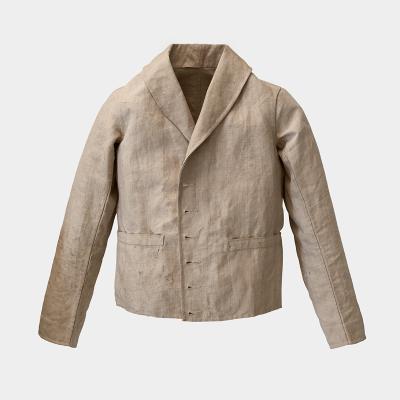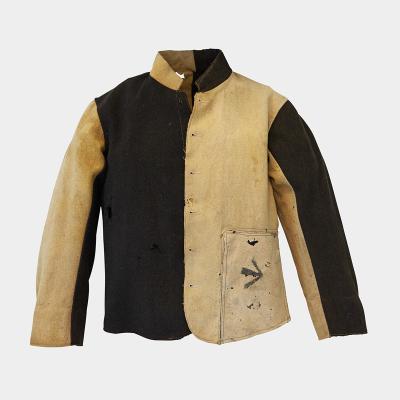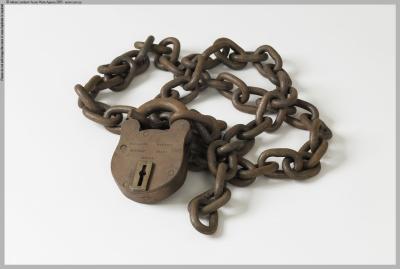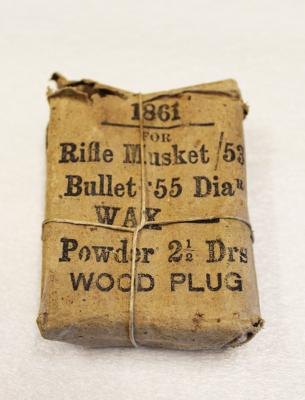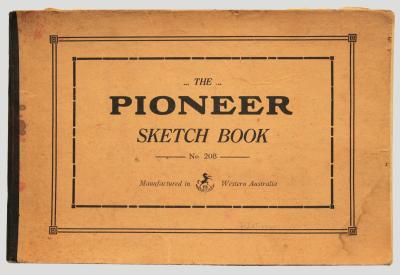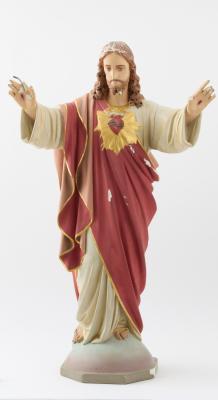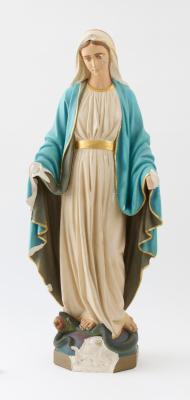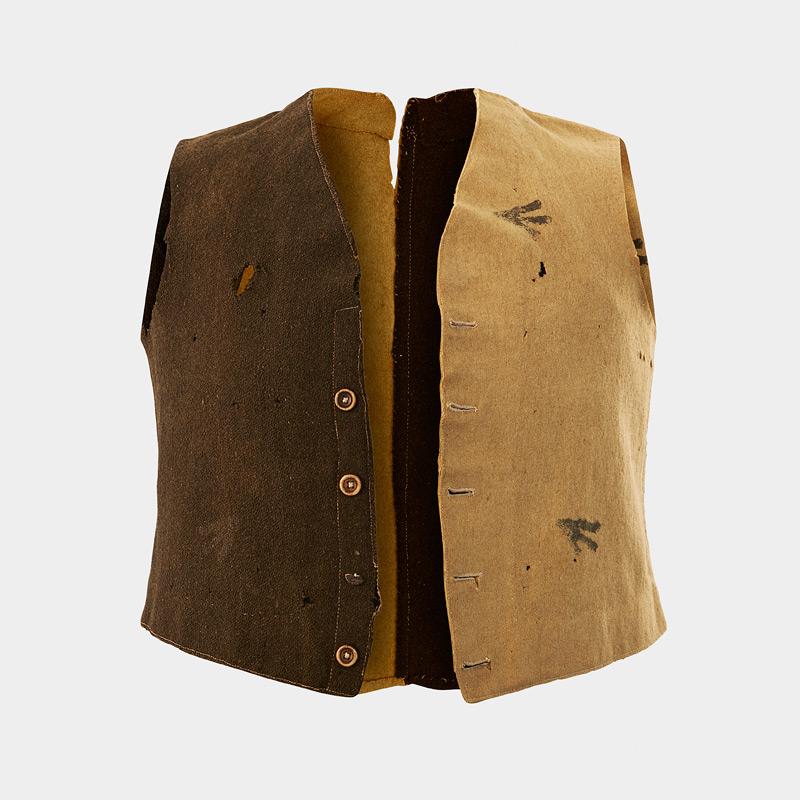WAISTCOAT FOR CONVICT
1850 - 1886Small, brown and yellow, woollen, waistcoat. The machine-made particoloured waistcoat is made up of alternating panels of yellow and black coarsely felted, woollen, plain weave, fabric. It has a centre front opening for five bone button fastenings and five corresponding handstitched buttonholes, measuring 20mm each. Only three and a half buttons remain attached, each measuring 15mm in diameter. The neck of the waistcoat is in a 'V' shape, with no collar. Six broad arrows are stencilled in black on the garment: two broad arrows are stamped on the front left yellow panel and one on the front right black panel. Two broad arrows are stamped on the back right yellow panel and one on the back left black panel.
Provenanced to Fremantle Prison
Details
Details
There are five pieces of intact convict clothing which survive in Western Australia. Two pieces (a jacket and a pair of trousers) belong to the Western Australian Museum, whilst the remaining three pieces belong to the Fremantle Prison Collection. These are a parti-coloured waistcoat (1978.96), a parti-coloured jacket (1979.2), and an unbleached linen jacket (1979.1).
Institutional clothing for convicts was an innovation of the prison reform movement of the late eighteenth century. Before this, prisoners either paid for, or provided their own, clothing.
There were nearly 10,000 male convicts transported from Britain to Western Australia between 1850 and 1868, and almost all of their uniforms were supplied from England. Convict uniforms were made in the tailor shops of the big London prisons in three standard sizes, and sent out in annual despatches. Sometimes they were made on the convict ships as they sailed from Britain to Western Australia.
Ordinary prisoners, ticket-of-leave men and men on special punishment, such as hard labour, wore different uniforms. The parti-coloured jacket (1979.2) and waistcoat (1978.96) in the Fremantle Prison Collection are examples of the uniform issued to convicts sentenced to hard labour, or those on work gangs outside the Prison. The vest and jacket would have been worn with trousers of the same fabric and colour, leading to the wearers being referred to as ‘magpies’ or ‘canaries’. The colour of the uniform assisted in surveillance and identification, and was an effective symbol of dishonour. The coarse wool that these garments are made from would have further contributed to the men’s discomfort and punishment.
The linen jacket in the Fremantle Prison Collection (1979.1) is an example of the summer uniforms issued to ordinary prisoners. Ordinary convicts were issued with two seasonal uniforms throughout the year; a winter uniform, issued in early May, made of coarse dark grey woollen fabric, and a summer uniform, issued in early November, made from duck (a fine unbleached canvas, of which the Fremantle Prison jacket is an example), dowlas (strong calico) or drabbet (dull brown linen). Along with these seasonally appropriate items, convicts were also issued with boots, a belt, socks, handkerchiefs and a felt hat.
All three pieces of Fremantle Prison’s convict clothing have the broad arrow mark stamped on them. This mark originated with Henry, Earl of Romney who was the Master General of Ordnance from 1693 to 1702. The broad arrow was used in his coat of arms and adopted as the symbol for ordinance in the British Army, and to signify any British Government property as a deterrent against theft. The unbleached canvas jacket (1979.1) is also stamped with ‘W D’, meaning War Department, which was the name of the government office which supplied common uniforms for the lowest ranks of the army and navy, as well as for convicts from 1854 to 1895. Further to this the manufacturers' stamps on this jacket also includes the date 1865.
The waistcoat and two jackets have been a part of the Fremantle Prison Collection since the Museum first opened in 1978. Whilst no specific provenance related to these items has been recorded, their existence in the original collection means they have very likely been on site at Fremantle Prison since the time of their use.
Some scientific analysis has been carried out on the parti-coloured waistcoat (1978.96) and jacket (1979.2) to help determine the techniques used to create the colours of the cloth. Electron microscopic analysis revealed that the yellow dye was derived from tin, and that the black dye was chromium. Both colours were probably fixed with alum.
Through their direct association with the historical era from which the Fremantle Prison site gains its World Heritage listing, the convict clothing in the Fremantle Prison Collection is of individual international significance. Few examples of the clothing worn by convicts sent to the Australian penal colonies survive, owing to the harsh conditions in which these men lived and the everyday needs of convicts, such as clothing, being underfunded during this period. These artefacts also provide an avenue for scientific analysis into nineteenth century cloth manufacturing and dye production.
